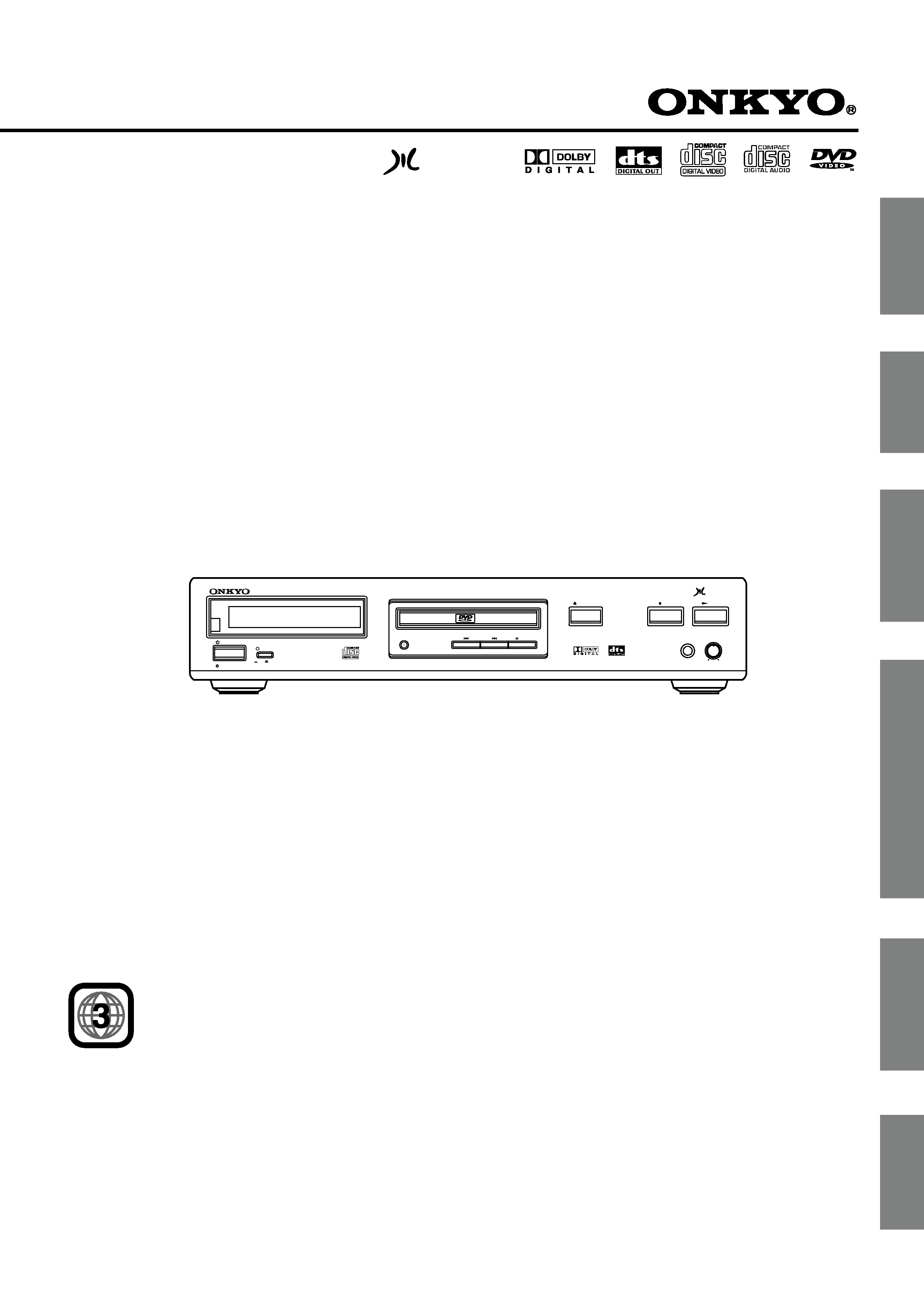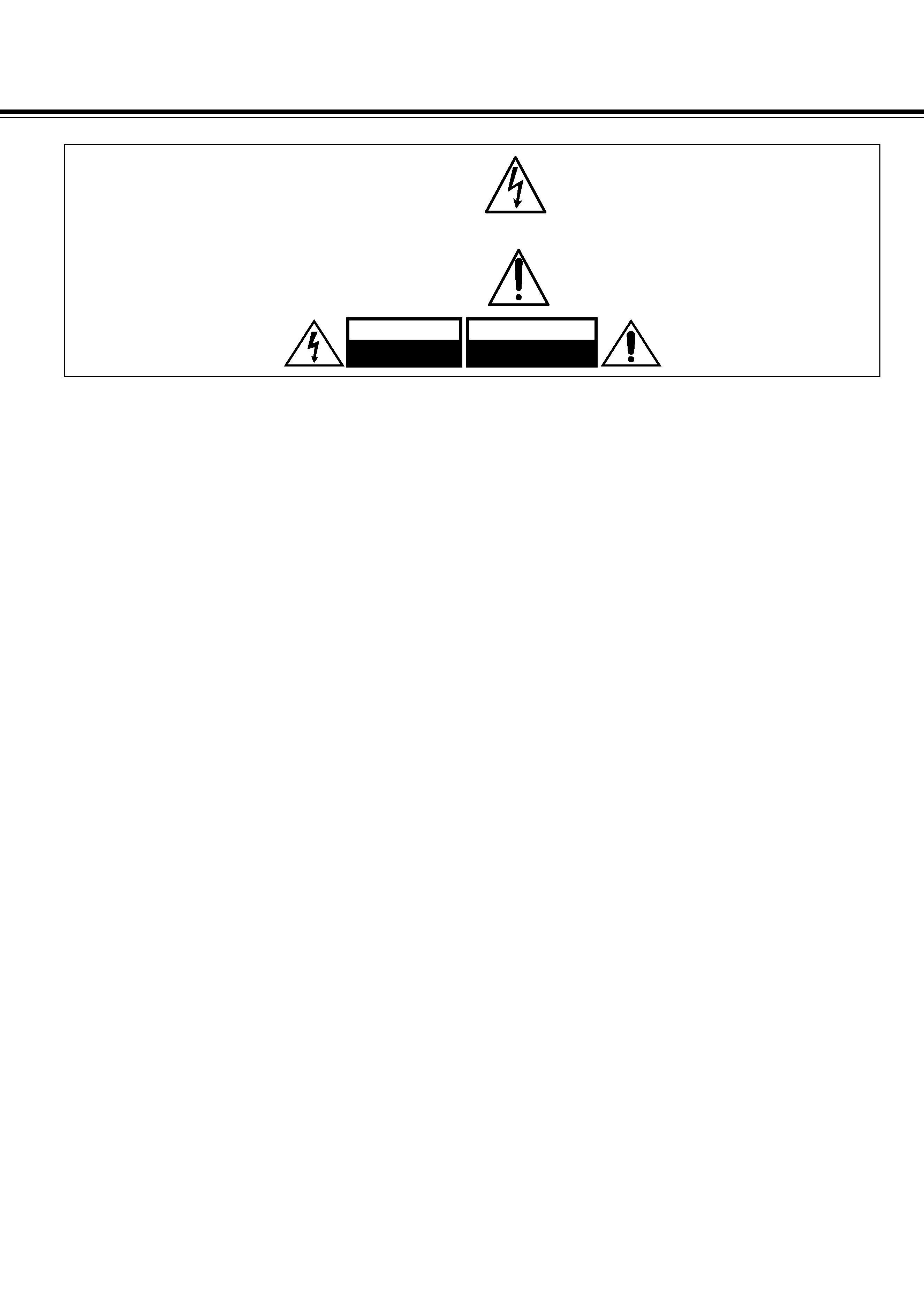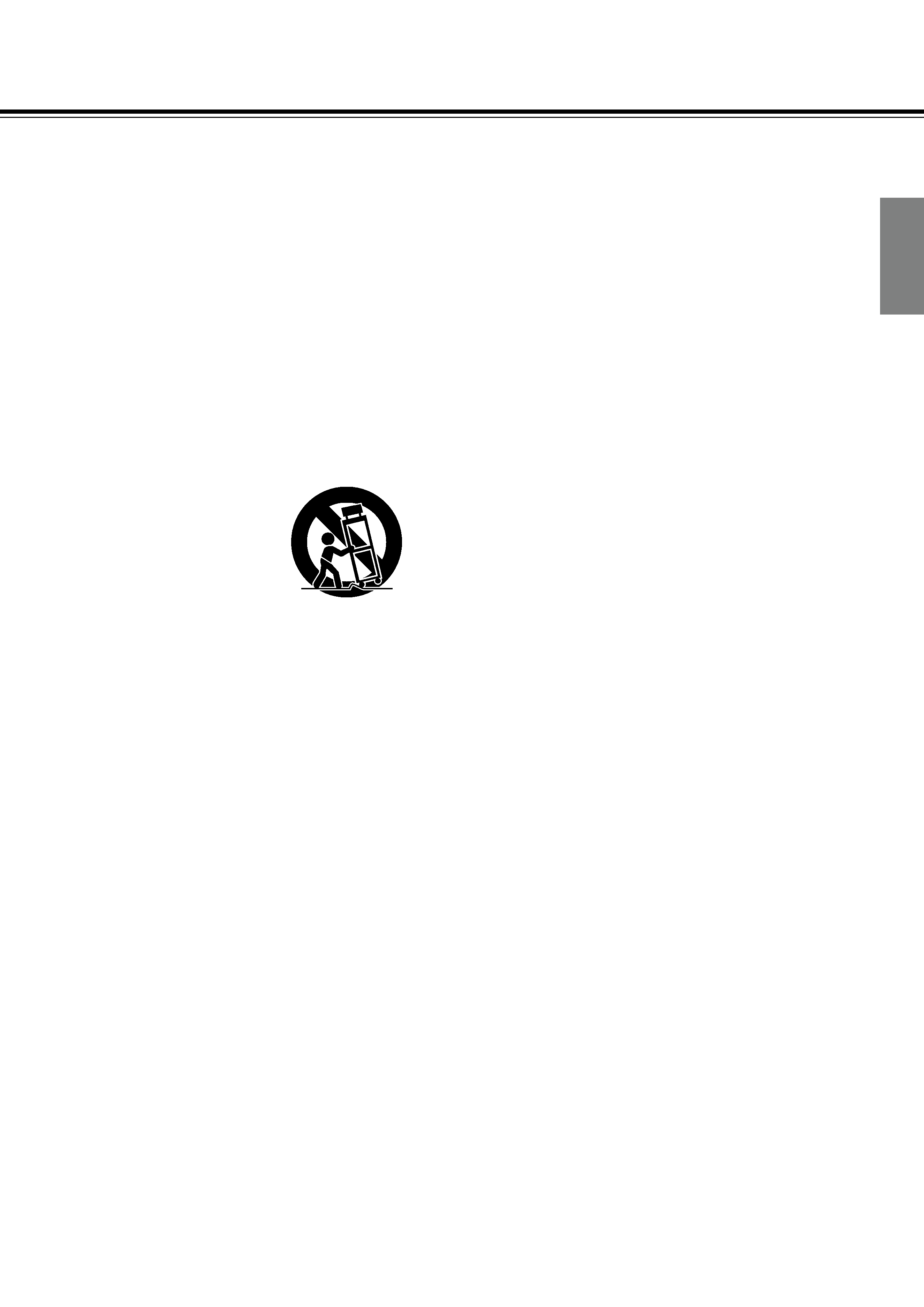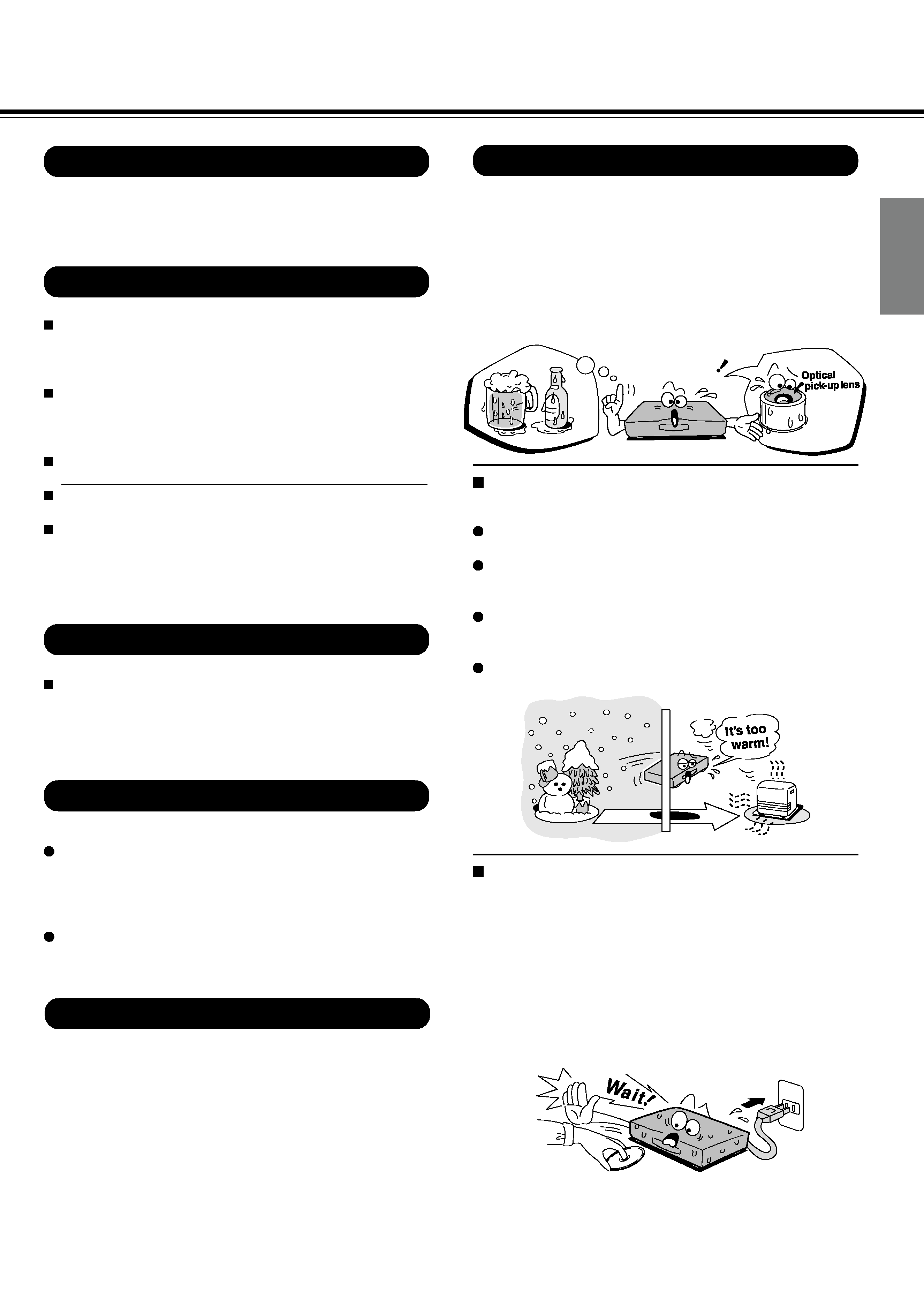
DV-S525
DVD Player
Instruction Manual
Connections
Intr
oduction
Basic
Pla
ybac
k
Other
s
Function
Setup
Ad
v
anced
Pla
ybac
k
Thank you for your purchase of the Onkyo DVD player.
Please read this manual thoroughly before making connections
and turning on the power.
Following the instructions in this manual will enable you to
obtain optimum performance and listening enjoyment from your
new DVD player.
Please retain this manual for future reference.
THIS DVD PLAYER IS MANUFACTURED FOR PLAYBACK
OF REGION 3 (SOUTHEAST ASIA) ENCODED DVD
SOFTWARE. USE OF SOFTWARE NOT INTENDED FOR
REGION 3 PLAYBACK MAY RESULT IN UNDESIRABLE
PLAYER PERFORMANCE.
MPEG
Multichannel
STANDBY/ON
STANDBY
POWER
OFF
ON
PHONES LEVEL
MIN
MAX
PHONES
DVD/ VIDEO CD/ CD PLAYER
DV-S
525
OPEN/CLOSE
STOP
PLAY
DIMMER
PAUSE
MPEG
Multichannel

2
Safety Precautions
The lightning flash with arrowhead symbol, within an
equilateral triangle, is intended to alert the user to the
presence of uninsulated "dangerous voltage" within the
product's enclosure that may be of sufficient magnitude
to constitute a risk of electric shock to persons.
The exclamation point within an equilateral triangle is
intended to alert the user to the presence of important
operating and maintenance (servicing) instructions in
the literature accompanying the product.
"WARNING"
"TO REDUCE THE RISK OF FIRE OR ELECTRIC SHOCK,
DO NOT EXPOSE THIS APPLIANCE TO RAIN OR
MOISTURE."
CAUTION:
"TO REDUCE THE RISK OF ELECTRIC SHOCK, DO NOT
REMOVE COVER (OR BACK). NO USER-SERVICEABLE
PARTS INSIDE. REFER SERVICING TO QUALIFIED
SERVICE PERSONNEL."
WARNING
AVIS
RISK OF ELECTRIC SHOCK
DO NOT OPEN
RISQUE DE CHOC ELECTRIQUE
NE PAS OUVRIR

3
Intr
oduction
13. Cleaning The appliance should be cleaned only as
recommended by the manufacturer.
14. Nonuse Periods The power cord of the appliance
should be unplugged from the outlet when left unused
for a long period of time.
15. Object and Liquid Entry Care should be taken so
that objects do not fall and liquids are not spilled into
the enclosure through openings.
16. Damage Requiring Service The appliance should
be serviced by qualified service personnel when:
A. The power-supply cord or the plug has been
damaged; or
B. Objects have fallen, or liquid has been spilled into
the appliance; or
C. The appliance has been exposed to rain; or
D. The appliance does not appear to operate normally
or exhibits a marked change in performance; or
E. The appliance has been dropped, or the enclosure
damaged.
17. Servicing The user should not attempt to service the
appliance beyond that described in the operating
instructions. All other servicing should be referred to
qualified service personnel.
1. Read Instructions All the safety and operating
instructions should be read before the appliance is
operated.
2. Retain Instructions The safety and operating
instructions should be retained for future reference.
3. Heed Warnings All warnings on the appliance and in
the operating instructions should be adhered to.
4. Follow Instructions All operating and use
instructions should be followed.
5. Water and Moisture The appliance should not be
used near water for example, near a bathtub,
washbowl, kitchen sink, laundry tub, in a wet
basement, or near a swimming pool, and the like.
6. Carts and Stands The appliance should be used
only with a cart or stand that is recommended by the
manufacturer.
6A. An appliance and cart
combination should be
moved with care. Quick
stops, excessive force,
and uneven surfaces
may cause the
appliance and cart
combination to overturn.
7. Wall or Ceiling Mounting The appliance should be
mounted to a wall or ceiling only as recommended by
the manufacturer.
8. Ventilation The appliance should be situated so that
its location or position does not interfere with its proper
ventilation. For example, the appliance should not be
situated on a bed, sofa, rug, or similar surface that may
block the ventilation openings; or if placed in a built-in
installation, such as a book case or cabinet that may
impede the flow of air through the ventilation openings,
there should be free space of at least 5 cm (2 in.) and
open up behind the appliance.
9. Heat The appliance should be situated away from heat
sources such as radiators, heat registers, stoves, or
other appliances (including amplifiers) that produce heat.
10. Power Sources The appliance should be connected
to a power supply only of the type described in the
operating instructions or as marked on the appliance.
11. Polarization If the appliance is provided with a
polarized plug having one blade wider than the other,
please read the following information: The polarization
of the plug is a safety feature. The polarized plug will
only fit the outlet one way. If the plug does not fit fully
into the outlet, try reversing it. If there is still trouble, the
user should seek the services of a qualified electrician.
Under no circumstances should the user attempt to
defeat the polarization of the plug.
12. Power- Cord Protection Power-supply cords should
be routed so that they are not likely to be walked on or
pinched by items placed upon or against them,
especially wear plugs, convenience receptacles, and
the point where they exit from the appliance.
Important Safeguards
PORTABLE CART WARNING
S3125A

4
Precautions
"CLASS 1 LASER
PRODUCT "
DANGER:
INVISIBLE LASER RADIATION WHEN OPEN AND INTERLOCK FAILED OR DEFEATED. AVOID DIRECT
EXPOSURE TO BEAM.
CAUTION:
THIS PRODUCT UTILIZES A LASER. USE OF CONTROLS OR ADJUSTMENTS OR PERFORMANCE OF
PROCEDURES OTHER THAN THOSE SPECIFIED HEREIN MAY RESULT IN HAZARDOUS RADIATION
EXPOSURE.
1. This unit is a CLASS 1 LASER PRODUCT and employs a laser inside the cabinet.
2. To prevent the laser from being exposed, do not remove the cover. Refer servicing to
qualified personnel.
WARNING:
Changes or modifications made to this equipment, not expressly approved by Onkyo, or parties authorized by
Onkyo, could void the user's warrantee of the equipment.

5
Intr
oduction
Moisture condensation occurs during the
following cases.
When you bring the DVD player directly from a cold place
to a warm place.
When you use the DVD player in a room where you just
turned on the heater, or a place where the cold wind from
the air conditioner directly hits the unit.
In summer, when you use the DVD player in a hot and
humid place just after you move the unit from an air
conditioned room.
When you use the DVD player in a humid place.
Notes on moisture condensation
Moisture condensation damages the DVD player.
Please read the following carefully.
Moisture condensation occurs, for example, when you pour a
cold drink into a glass on a warm day. Drops of water form on
the outside of the glass. In the same way, moisture may
condense on the optical pick-up lens inside this unit, one of
the most crucial internal parts of the DVD player.
Do not use the DVD player when moisture
condensation may occur.
If you use the DVD player in such a situation, it may
damage discs and internal parts. Remove the disc, connect
the power cord of the DVD player to the wall outlet, turn on
the DVD player, and leave it for two or three hours. After
two or three hours, the DVD player will have warmed up
and evaporated any moisture. Keep the DVD player
connected to the wall outlet and moisture condensation will
seldom occur.
Notes on handling
When shipping the DVD player, the original shipping carton
and packing materials come in handy. For maximum
protection, repack the unit as it was originally packed at the
factory.
Do not use volatile liquids, such as insect spray, near the
DVD player. Do not leave rubber or plastic products in
contact with the DVD player for a long time. They will leave
marks on the finish.
The top and rear panels of the DVD player may become
warm after a long period of use. This is not a malfunction.
When the DVD player is not in use, be sure to remove the
disc and turn off the power.
If you do not use the DVD player for a long period, the unit
may not function properly in the future. Turn on and use the
DVD player occasionally.
Notes on placement
When you place this DVD player near a TV, radio, or VCR,
the playback picture may become poor and the sound may
be distorted. In this case, place the DVD player away from
the TV, radio, or VCR.
Notes on cleaning
Use a soft, dry cloth for cleaning.
For stubborn dirt, soak the cloth in a weak detergent
solution, wring well and wipe. Use a dry cloth to wipe it dry.
Do not use any type of solvent, such as thinner and
benzine, as they may damage the surface of the DVD
player.
If you use a chemical saturated cloth to clean the unit,
follow that product's instructions.
To obtain a clear picture
The DVD player is a high technology, precision device. If the
optical pick-up lens and disc drive parts are dirty or worn
down, the picture quality becomes poor. To obtain a clear
picture, we recommend regular inspection and maintenance
(cleaning or parts replacement) every 1,000 hours of use
depending on the operating environment. For details, contact
your nearest dealer.
Examples of moisture
condensation
Warranty claim
You can find the serial number on the rear panel. In case of
warranty claim, please report this number.
